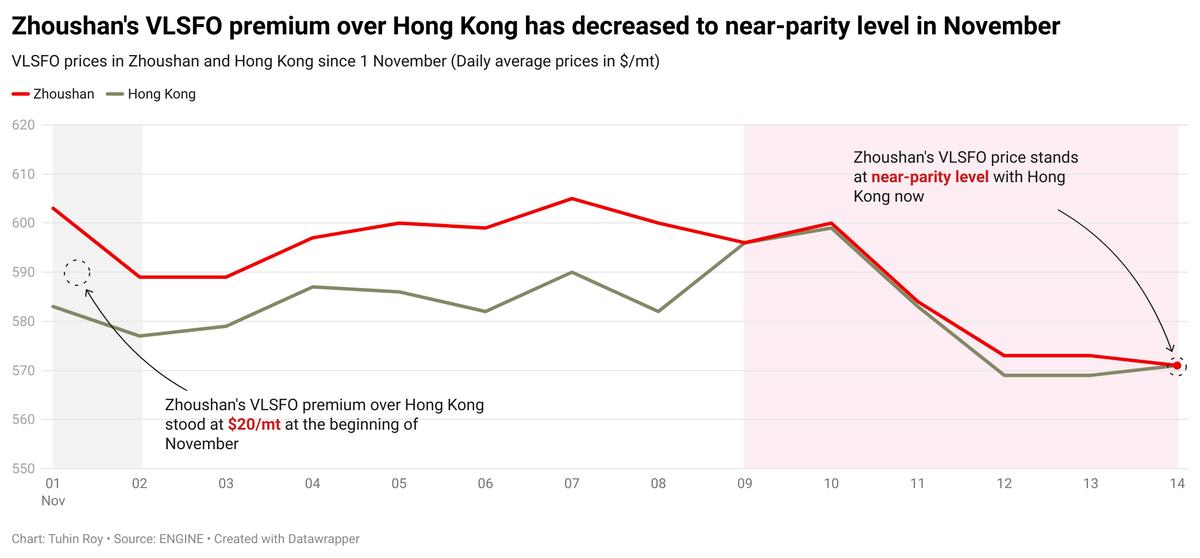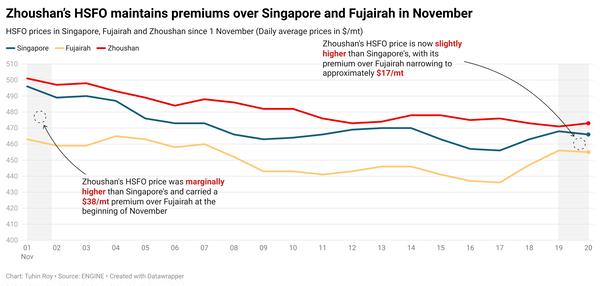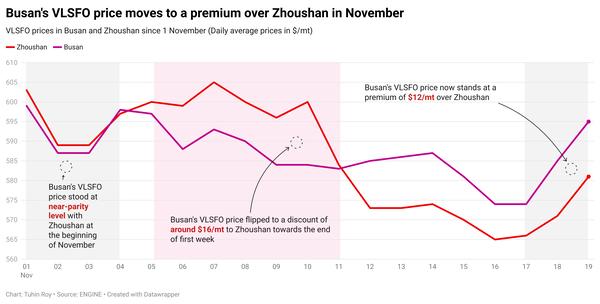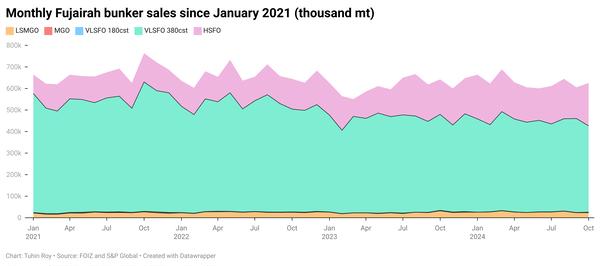East of Suez Market Update 14 Nov 2024
Prices in East of Suez ports have been broadly rangebound, and bunker deliveries in Hong Kong remain suspended due to Tropical Cyclone Toraji-induced adverse weather.

Changes on the day, to 17.00 SGT (09.00 GMT) today:
- VLSFO prices up in Singapore ($3/mt), unchanged in Zhoushan, and down in Fujairah ($2/mt)
- LSMGO prices up in Fujairah ($6/mt) and Zhoushan ($2/mt), and down in Singapore ($1/mt)
- HSFO prices up in Fujairah ($4/mt), Singapore and Zhoushan ($3/mt)
Bunker benchmarks in East of Suez ports have remained mostly stable in the past day, with no significant changes. Zhoushan continues to price its VLSFO at elevated levels, with premiums of $17/mt and $8/mt over Fujairah and Singapore, respectively.
Availability in Zhoushan remains steady amid low bunker demand, with suppliers recommending lead times of 5–7 days, similar to last week.
In Northern China, ports such as Dalian and Qingdao have sufficient supplies of VLSFO and LSMGO, though Qingdao is facing limited HSFO availability. Tianjin is experiencing tight supplies of HSFO and LSMGO, but VLSFO availability remains adequate. In Shanghai, LSMGO is readily available, while VLSFO and HSFO are in short supply.
Meanwhile, bunker deliveries in Hong Kong have been suspended since yesterday due to adverse weather conditions caused by Tropical Cyclone Toraji, a source said. The suspension is likely to stay in effect until further notice, the source added. Hong Kong’s VLSFO price is near parity with the neighboring Zhoushan port.
Brent
The front-month ICE Brent contract has moved $0.13/bbl higher on the day, to trade at $72.40/bbl at 17.00 SGT (09.00 GMT).
Upward pressure:
Brent futures gained some upward support after the American Petroleum Institute (API) projected a decline in US crude oil stocks.
Crude oil inventories in the US dropped by 770,000 bbls in the week that ended 8 November, according to the API estimates.
The weekly inventory drop was against market expectations of a 1 million-bbl rise. A fall in US crude stocks indicates growth in oil demand, which can put upward pressure on Brent’s price.
Additionally, US inflation data suggested a gradual approach toward the US Federal Reserve's (Fed) 2% target. The US inflation rate, measured by the change in the Consumer Price Index (CPI), came in flat at 0.2% in October, matching the previous month's figure.
“The consumer price index met expectations, easing fears of a surprise uptick that might have thrown a wrench in the Fed’s easing plans,” SPI Asset Management’s managing partner Stephen Innes remarked.
Focus will remain on the International Energy Agency’s (IEA) monthly forecast for global oil demand, analysts said. “Oil traders are on edge as the International Energy Agency (IEA) prepares to release its latest monthly oil market report,” Innes added.
Downward pressure:
Oil market traders have reacted to “unconfirmed reports” of a complete overturn in diplomatic relations, analysts said, suggesting that Iran is opting not to retaliate against Israel, following Donald Trump’s victory in the 47th US presidential election.
“Any response may now not come until negotiations with the new administration begin,” ANZ Bank’s senior commodity strategist Daniel Hynes said.
Brent’s price felt some downward pressure after OPEC cut its forecast for oil demand growth in its latest oil market report. The Saudi Arabia-led group expects oil consumption to increase by 1.8 million b/d this year, about 107,000 b/d lower than its previous month's projection.
“It [OPEC] attributed the change to weakening demand in China and India,” Hynes said.
By Tuhin Roy and Aparupa Mazumder
Please get in touch with comments or additional info to news@engine.online

Contact our Experts
With 50+ traders in 12 offices around the world, our team is available 24/7 to support you in your energy procurement needs.





